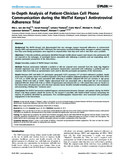| dc.description.abstract | Background
The WelTel Kenya1 trial demonstrated that text message support improved adherence to antiretroviral therapy (ART) and suppression of HIV-1 RNA load. The intervention involved sending weekly messages to patients inquiring how they were doing; participants were required to respond either that they were well or that there was a problem.
Objectives
1) Describe problems participants identified through mobile phone support and reasons why participants did not respond to the messages; 2) investigate factors associated with indicating a problem and not responding; and 3) examine participant perceptions of the intervention.
Design
Secondary analysis of WelTel Kenya1 trial data.
Methods
Reasons participants indicated a problem or did not respond were extracted from the study log. Negative binomial regression was used to determine participant characteristics associated with indicating a problem and non-response. Data from follow-up questionnaires were used to describe participant perceptions of the intervention.
Results
Between 2007 and 2009, 271 participants generated 11,873 responses; 377 of which indicated a problem. Health issues were the primary reason for problem responses (72%). Rural residence (adjusted incidence rate ratio [IRR] 1.96; 95%CI 1.19–3.25; p = 0.009 and age were associated with indicating a problem (adjusted IRR 0.63 per increase in age group category; 95%CI 0.50–0.80; p<0.001). Higher educational level was associated with a decreased rate of non-response (adjusted IRR 0.81; 95%CI 0.69–0.94; p = 0.005). Of participants interviewed, 62% (n = 129) stated there were no barriers to the intervention; cell phone issues were the most common barrier. Benefits included reminding patients to take medication and promoting a feeling that “someone cares”.
Conclusions
The WelTel intervention enabled frequent communication between clinicians and patients during the WelTel Kenya1 trial. Many patients valued the service for the support it provided, with health-related concerns comprising the majority of problems identified by participants. Few sociodemographic characteristics were associated with participant engagement in the intervention. | en |

